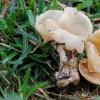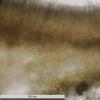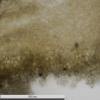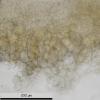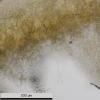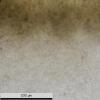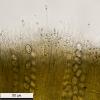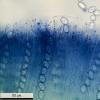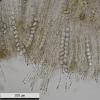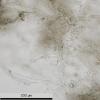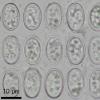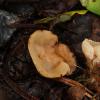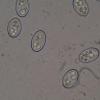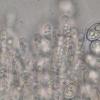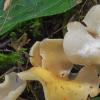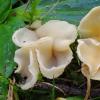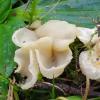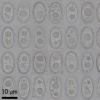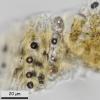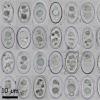
15-12-2025 15:48
 Danny Newman
Danny Newman
Melanospora cf. lagenaria on old, rotting, fallen

15-12-2025 15:54
 Johan Boonefaes
Johan Boonefaes
Unknown anamorph found on the ground in coastal sa

15-12-2025 21:11
 Hardware Tony
Hardware Tony
Small clavate hairs, negative croziers and IKI bb

15-12-2025 07:09
 Danny Newman
Danny Newman
indet. Rutstroemiaceae sp. on unk. fallen leavesMc

15-12-2025 07:05
 Danny Newman
Danny Newman
Pseudosclerococcum golindoi┬Ā(det: Zotto)near Cosb

15-12-2025 11:49
 Danny Newman
Danny Newman
ITS sequences from the following two collections B

15-12-2025 12:34
 Danny Newman
Danny Newman
indet. Rhytismataceae on oak leafnear Purchase Roa

09-12-2025 12:06
 Andgelo Mombert
Andgelo Mombert
Bonjour,Je recherche l'article concernant Hypobryo
 Good night
Good nightI have this weird stipitate white-orange 2,5-3 cm tall ┬┐Helvella? under hazel (Corylus avellana) at 1.200 m in Pirineos.
Asci 8-spores, inamyloid, I didn' check croziers, sorry.
Spores ellipsoidal with 3-4 not very clear guttules,┬Ā(13.0) 13.4 - 14.8 (15.7) x (8.2) 8.8 - 9.8 (10.0) ┬Ąm;┬ĀQ = (1.3) 1.5 - 1.6 (1.7); N = 46;┬ĀMe = 14.2 x 9.2 ┬Ąm ; Qe = 1.5
Paraphysis straight, slightly broad at apex, with medium-size VBs.
Ectal excipullum with textura angularis and with globose furfuraceous cells at outer surface.
Medullar excipulum with textura intricata.
Thank you.
Miguel Á. Ribes


I have find S. laevispora, with smooth spores, but bigger: 17-30,5 x 10-13,5 and with 2 big guttules.
Any other nearest genus?┬Ā
Thank you
Hello,
We have probably collected the same thing in Sweden. At least spores and paraphyses seem identical. I identified it tentatively to Arpinia inops. The only thing was that the spores are said to be "biguttulate (or more often) uniguttulate" by Hohmeyer (1988). I wondered whether the guttules can fuse in dried material.
I coul not check the original description of A. inops.
Cheers,
Ibai.

Good option, spores and paraphysis are identical.
I have the paper with the original description of Berthet 1974 and said: "Ce champignon a ├®t├® d├®couvert par notre coll├©gue N. ARPIN le┬Ā18 septembre 1967t lors d'une herborisation que nous avons faite ensemble┬Ādans la r├®gion des Gets (Haute-Savoiet France) ├Ā partir du Laboratoire ┬½ La┬ĀJaysinia ┬╗ ├Ā Samo├½ns" and in the description he said "Spores ovo├»des. lisses. pourvues d'une grosse guttule centrale, ou plus┬Ārarement de deux plus petites dispos├®es suivant le grand axe (fig. C) mesurant 13"15 x 9" 10 ┬Ąm. Exemple de dimensions sporales not├®es sur des spores┬Ām├╗res projet├®es par les asques: 12.5 x 10.5; 13 x 10; 13.5 x 9.5; 14 x 9.5;┬Ā14 x 9.5 ; 14 x 10; 14.5 x 9 ; 15 x 9.5 ┬Ąm"
Perhaps dried material has fused small-medium guttules in only one great central guttule.
I am sending you the paper.
Cheers.
Not an Helvella of course. In Arpinia┬ĀI know well enough only A. luteola, where the guttules are similar to a Tarzetta - Helvella and we should exclude that these kind of guttules may be the same, even in different fresh-dried condition.
But as this collection really looks like Arpinia inops, maybe Arpinia luteola, that is different also in the excipular strucutre, should be transferred in another genus...
┬Ā


1. Yes, LBs ┬Āshow a strong tendency to fuse in dead material. In A. luteola, however, there appear to be two rather large LBs already in the living state, very similar as in Otidea, judging from photos by J.P. Vidonne on my homepage (Cubby).
2. Did you compare A. rahmii? I have in Cubby images of a collection from the Erzgebirge mountains S of Chemnitz (HB 9595), with spores (*12-13 x 8-9 ┬Ąm) only slightly smaller than yours. They show the very same droplet pattern: medium-sized, several in each half. Also the VBs are present, which are typical of Otidea too.
┬ĀA. rahmii is in Schmid Ascomycetes 2, Nr. 56.
┬Ā
Zotto

Some spores in your pictures have the same patter than our collection, perhaps immature spores have several LBs and mature spores have two. I have some better macro pictures than collectors have sent me, perhaps later I could sent it, and perhaps this year they could find the species again more mature.


I have ask the collector if they conserve this dried material.


How did you asigned your collection HB9595 to Arpinia rahmii? Clearly it is an Arpinia, but how did you come to the conclusion of A. rahmii? Do you have more papers who talk about another different guttules pattern, like your collection, Ibai or mine?
Anyway, your spores measurement, are made in mature spores or spores inside the asci? Perhaps inmature spores are smaller and multiguttules and mature spores are bigger an biguttules. From your pictures I obtain, more or less, this measures:
(12.3) 12.4 - 13.4 (14.1) x (8.9) 9.0 - 10.1 ┬Ąm
Q = (1.2) 1.22 - 1.48 (1.5) ; N = 10
Me = 13.1 x 9.6 ┬Ąm ; Qe = 1.4
Hi Ibai
Do you have measures of your spores? Your spores were matture?
Thanks a lot.

This is the note I have for this collection:
Chemnitz, Pobershau, Picea forest, det. P. Welt. B. M├╝hler/P. Welt: Asci 170-225 x 14-15 ┬Ąm (but vital 16 ┬Ąm!). Sp. *12-13 x 8-9 ┬Ąm, several medium-sized and small LBs.
The microphotos were made by myself but I did not measure the spores. The above data were gained by Bernd and Peter, except for my statement of 16 ┬Ąm wide asci.
Thanks for re-measuring! Yes, I also see that the spores are around 10 ┬Ąm wide inside the asci. I do not expect remarkable size changes of such thick-walled spores after ejection. Anyhow it could well be that they shrink in the dead state. Schmid gives 11-13 x 7-8.5 (dead state). Maybe Peter identified it with Schmid Ascomyceten, or with the original literature, I don't know, but I can ask him.
The original paper in Hoppea we possibly have, i can look.
Zotto

Thanks a lot for all data. I haven't Hoppea paper, I will be very grateful. Peter Welt belongs to this forum, isn't it?┬Ā
I understand that thick-walled spores change his size after ejection less than thin-walled spores.
Best wishes.

I send you the A. rahmii description by mail
Zotto

Best wishes.

This afternoon I have examined again the dried material and surprise, a lot of spores have 2 big guttules and someone has only 1 bigger guttule. Perhaps tomorrow I could sent some pictures.
Thank you.

Here is the picture of dried spores with 1-2 big guttules. Some spores conserve the multiguttules pattern, but majority has 2 guttules.
┬Ā
And this are the new measures of dried spores, only 0,3-0,4 ┬Ąm smaller than live ones:
(12.7) 13.4 - 14.9 (15.2) x (7.6) 8.6 - 9.3 (9.6) ┬Ąm
Q = (1.4) 1.5 - 1.7 (1.8) ; N = 97
Me = 14.1 x 8.9 ┬Ąm ; Qe = 1.6
To compare, living spores measures:
(13.0) 13.4 - 14.8 (15.7) x (8.2) 8.8 - 9.8 (10.0) ┬Ąm
Q = (1.3) 1.5 - 1.6 (1.7) ; N = 46
Me = 14.2 x 9.2 ┬Ąm ; Qe = 1.5
It is curious to observe how spores have a multiggutulate pattern when live and biguttulate in dried material.
Although Hohmeyer has a spore size of 11-13 x 8-9 ┬Ąm, I don't find another possibility more than Arpinia rahmii.
Thank you.
Incredible! Good job, thanks! I will check the Swedish collection to see if it has now 1-2-guttulate spores after drying.
Cheers,
Ibai.

Cheers.

Zotto

In sort:
* Collected date: 08/10/2014
* First study, in vivo: 14/10/2014 (6 days later)
Spore size in H2O:┬Ā(13.0) 13.4 - 14.8 (15.7) x (8.2) 8.8 - 9.8 (10.0) ┬Ąm;
Q = (1.3) 1.5 - 1.6 (1.7); N = 46; Me = 14.2 x 9.2 ┬Ąm ; Qe = 1.5
* Second study, dried: 24/02/2015 (4 1/2 months later)
Spores size in H2O:┬Ā(12.7) 13.4 - 14.9 (15.2) x (7.6) 8.6 - 9.3 (9.6) ┬Ąm
Q = (1.4) 1.5 - 1.7 (1.8); N = 97;┬ĀMe = 14.1 x 8.9 ┬Ąm ; Qe = 1.6
* Third study, dried: 05/03/2015 (5 months later)
Spore size in KOH:┬Ā┬Ā(13.0) 13.6 - 15.1 (15.5) x (8.1) 8.4 - 9.4 (9.7) ┬Ąm
Q = (1.4) 1.5 - 1.7 (1.8); N = 76;┬ĀMe = 14.3 x 8.9 ┬Ąm ; Qe = 1.6
Spores in KOH preserved, as expected, 2 LB.┬ĀMounted in inmersion oil instead of water, all spores have a DBB.
Conclusion: no significant difference in spore size in vivo with H2O, dried (dead?) with H2O and dead with KOH.
Hypothesis 1: In my first studio the spores are dead, I don't think so, because spore size of your collection (Zotto) is similar. We don't know spores size in vivo from Ibai collection to compare.
Hypothesis 2: Spore size of Arpinia rahmii is not affected with the status vivo or dead.
Mystery or science?
Attaches spores mounted in oil and KOH.
